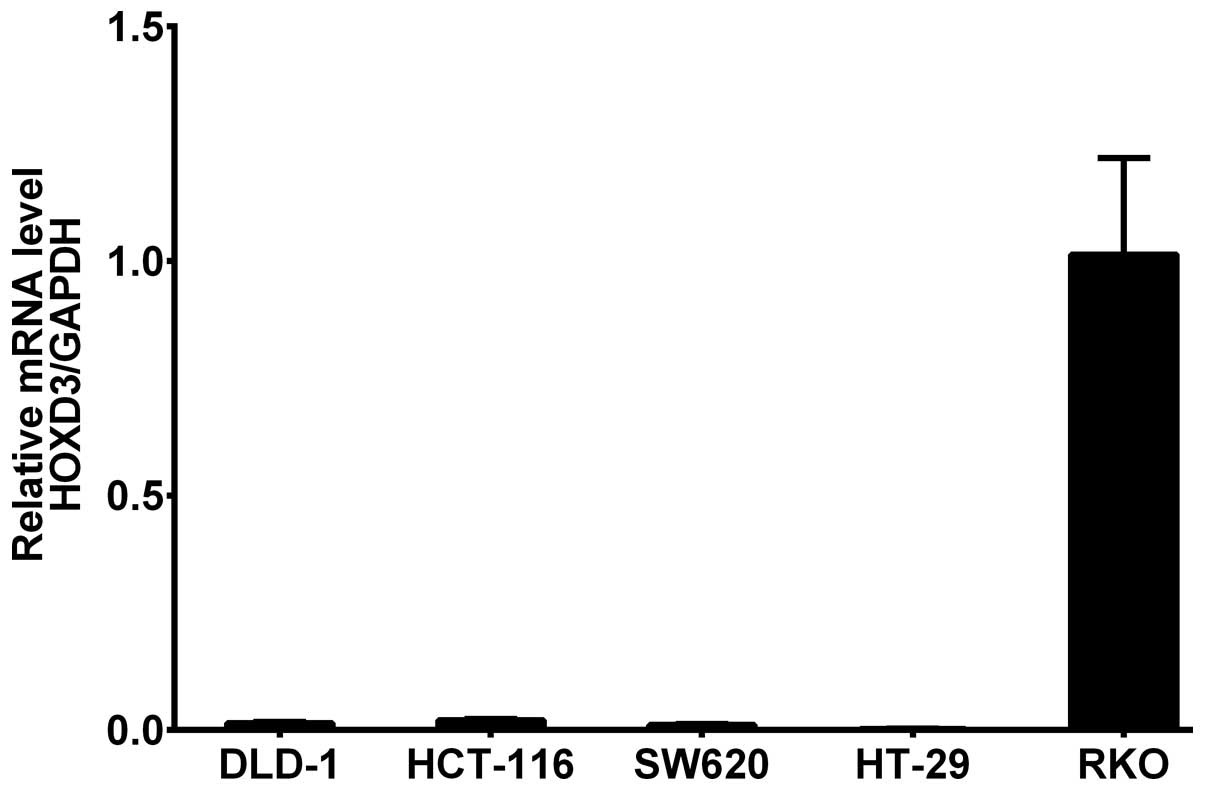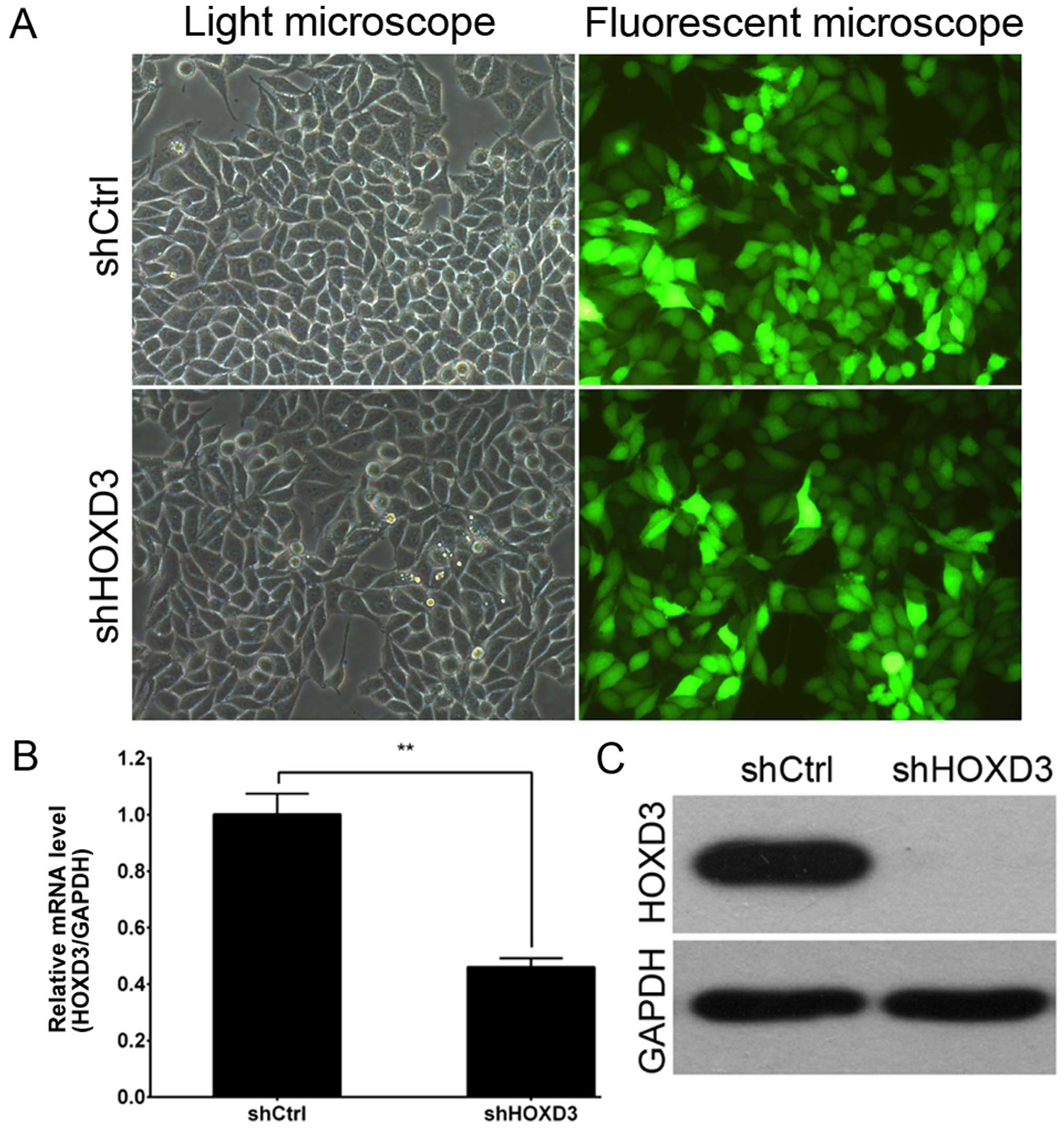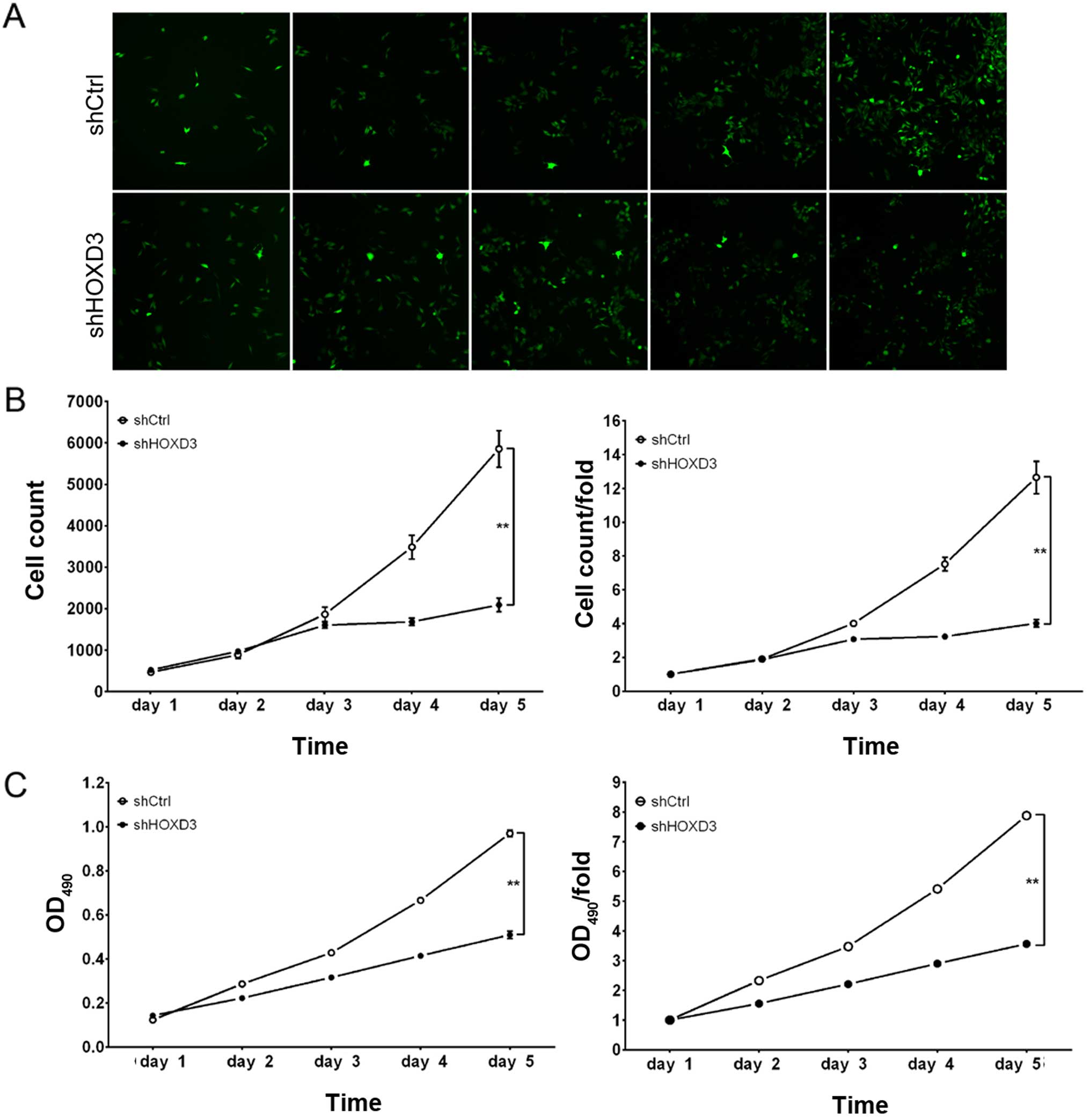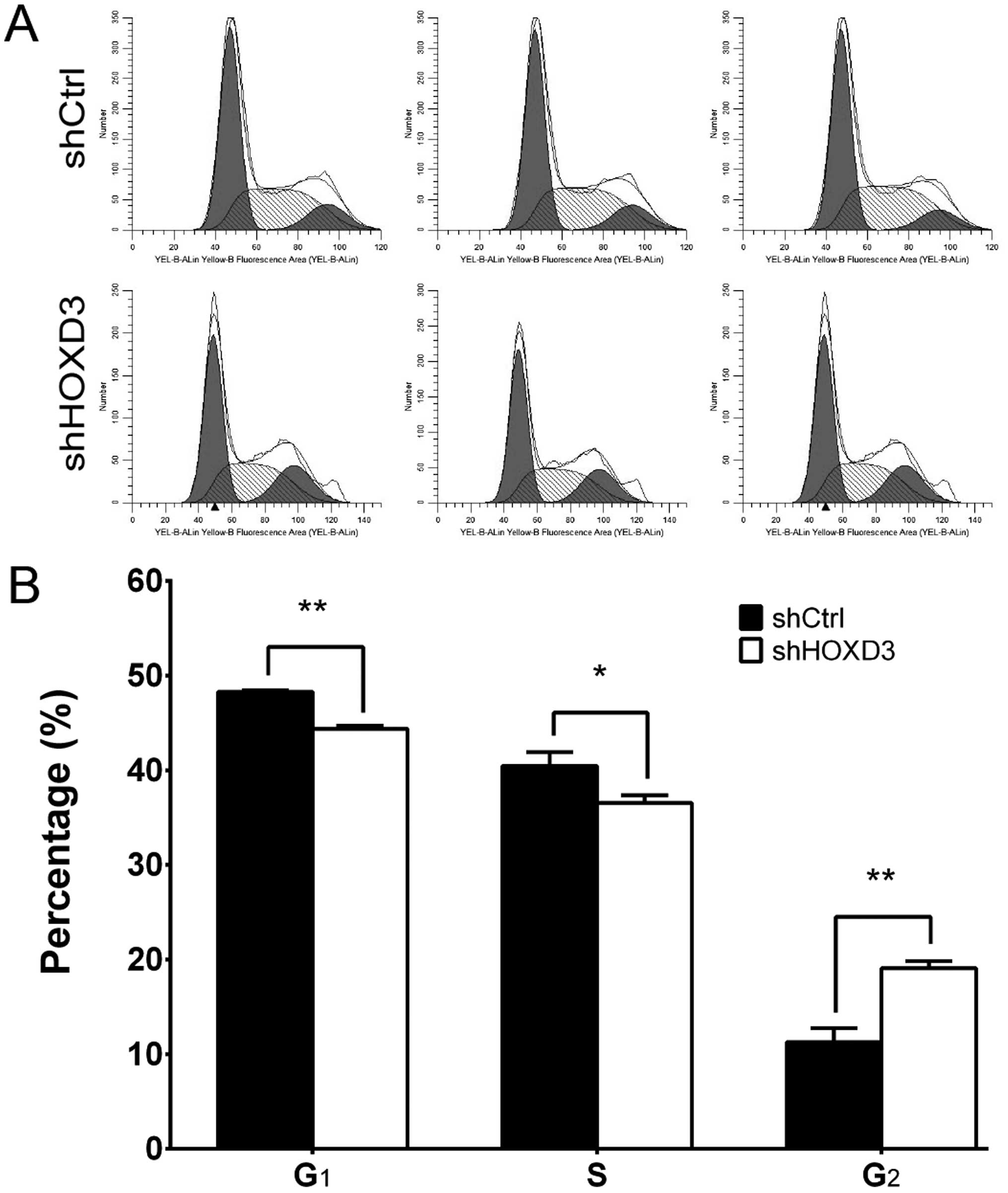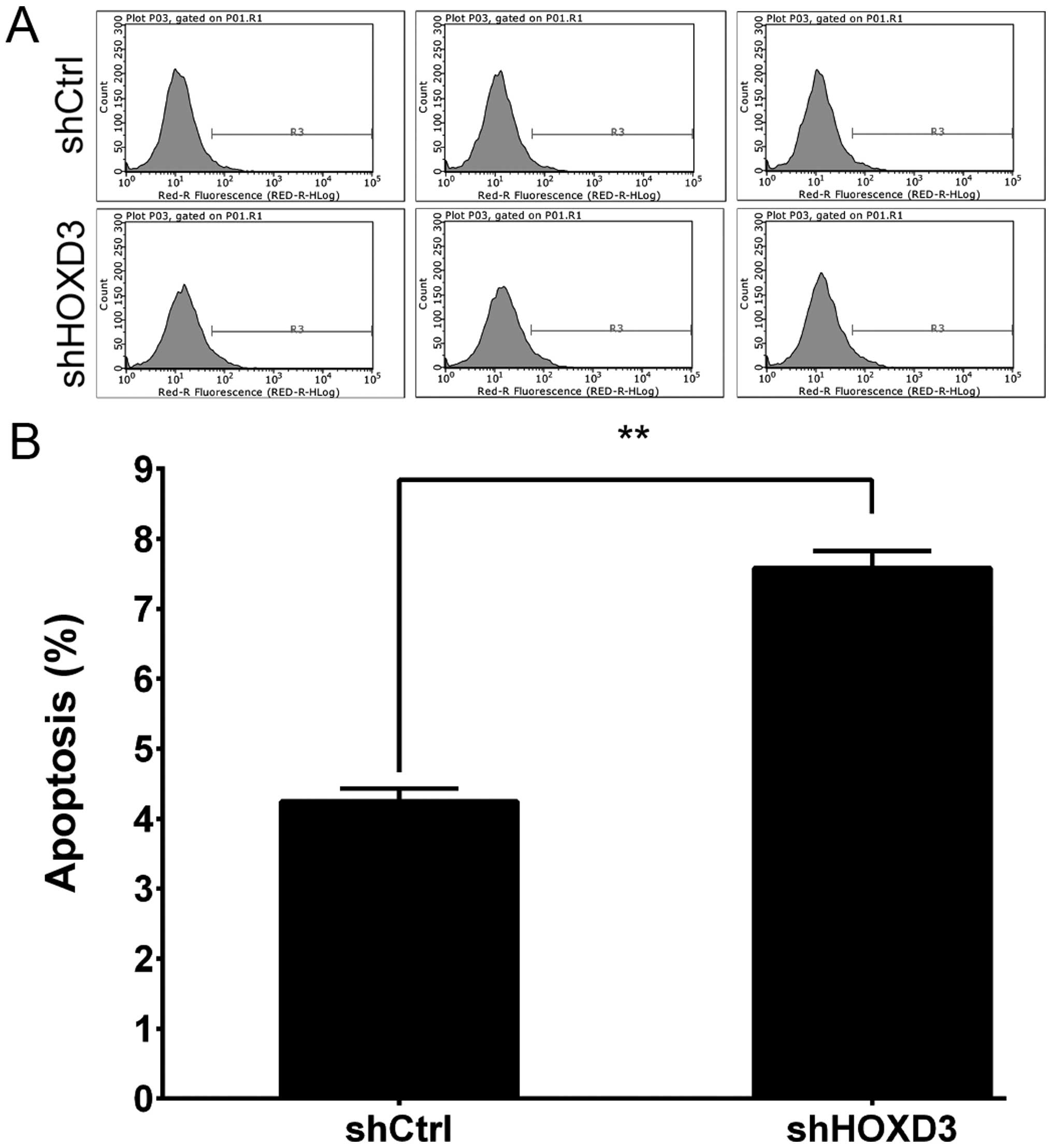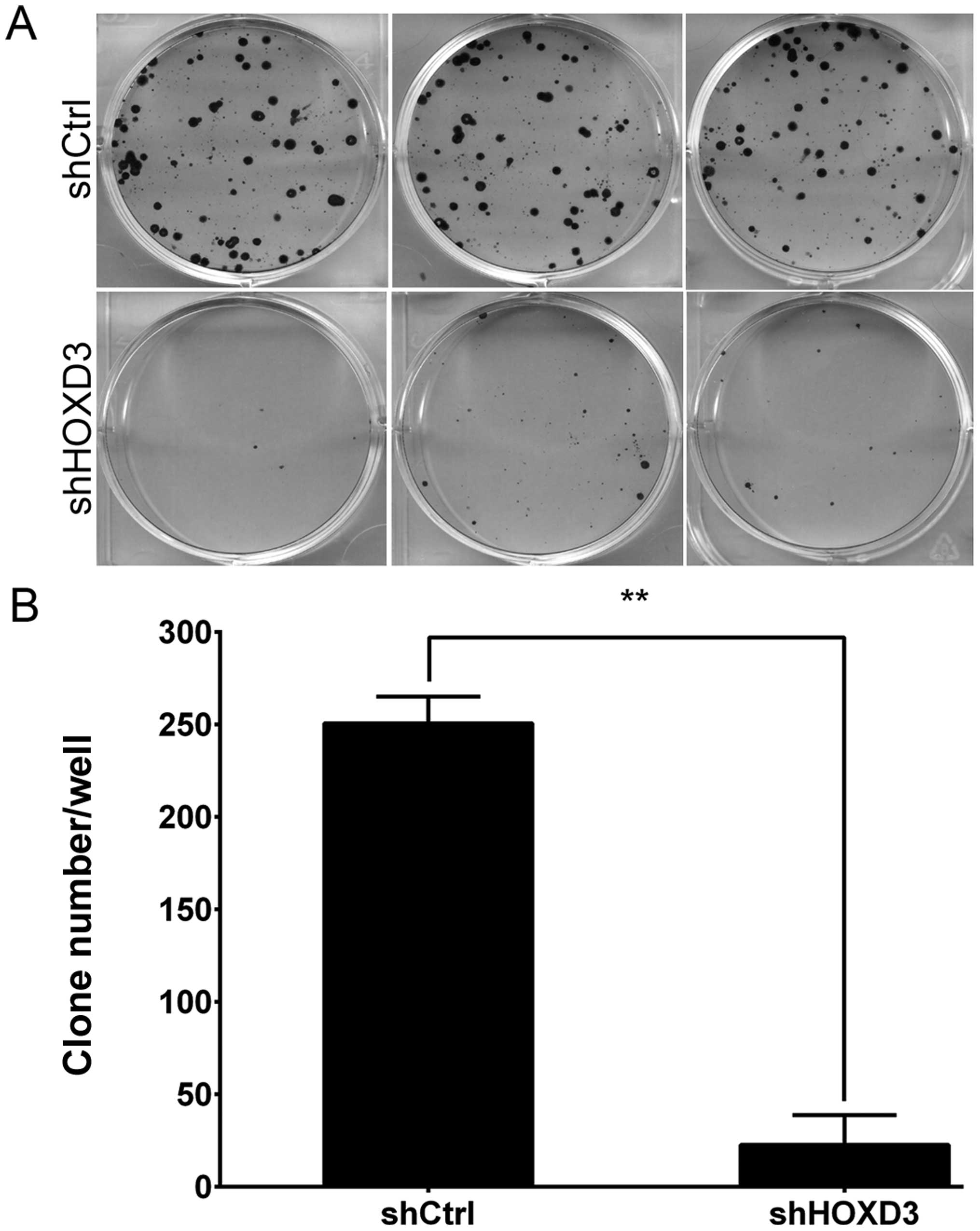RNAi-mediated HOXD3 knockdown inhibits growth in human RKO cells
- Authors:
- Published online on: August 2, 2016 https://doi.org/10.3892/or.2016.4993
- Pages: 1793-1798
-
Copyright: © Chen et al. This is an open access article distributed under the terms of Creative Commons Attribution License.
Abstract
Introduction
Worldwide, colorectal carcinoma (CRC) is one of the most common malignant cancers and is the second most frequent cause of cancer-related deaths (1–3). Despite marked advances in diagnostic and therapeutic approaches, the prognosis for CRC patients remains poor (4). Consequently, there is an urgent need to develop new CRC treatment methods.
Since homeobox-containing (HOX) genes encode DNA-binding proteins, they are master transcriptional regulators of cell differentiation, morphogenesis, and organogenesis during development (5,6). In humans and other mammals, 39 HOX genes are clustered in four complexes called HOXA, B, C, and D. These are further subdivided into 13 paralogous groups based on their sequence similarities and relative positions along the clusters (7–11). Mutational analyses demonstrated that HOXD genes play a pivotal role in determining the regional specificity of cells (12,13). For example, the HOXD13 gene is involved in the normal morphogenesis of limbs (12) and of the anal sphincter (13). HOXD3 is a member of the third paralogous group of the HOXD gene family and is involved in embryonic development (14,15).
Studies have shown that the human HOXD3 gene plays a multifunctional role in cancer. For example, HOXD3 overexpression was found to regulate cell adhesion in human erythroleukemia HEL cells (16), induce coordinate metastasis-related gene expression, and enhance the motility and invasiveness of human lung cancer A549 (17–19) and melanoma cells (20). Additionally, studies have shown that HOXD3 induces angiogenesis by increasing pro-angiogenic molecules (21–25). While these studies clearly demonstrated that HOXD3 is involved in the development and growth of various types of cancers, the functional role of HOXD3 in human CRC has not yet been determined.
In the present study, we demonstrated that HOXD3 is highly expressed in the human CRC RKO cell line. Consequently, we used a lentiviral vector to deliver small interfering RNA (siRNA) to knock down HOXD3 expression in the RKO cells. Finally, we assessed the effects of HOXD3 knockdown on human CRC cell growth and survival in vitro.
Materials and methods
Cell lines
DLD-1, HCT-116, SW620, HT-29, and RKO human colon carcinoma cell lines were purchased from the Shanghai Cell Bank of the Chinese Academy of Science (Shanghai, China). Cell lines were maintained in Dulbecco's modified Eagle's medium (DMEM; Corning, Shanghai, China) supplemented with 10% fetal bovine serum (FBS; Ausbian, Australia) at 37°C in a 5% CO2 incubator.
Quantitative RT-PCR
Total RNA was extracted from the cells in each group (DLD-1, HCT-116, SW620, HT-29, and RKO) using TRIzol reagent (Invitrogen, Carlsbad, CA, USA), according to the manufacturer's protocol. Two micrograms of total RNA from each sample was reverse transcribed to single-stranded cDNA. One microgram of cDNA was used as a template for the quantitative real-time PCR. The primers used were as follows: HOXD3 forward, 5′-CGG CAA CTT CGT CGA GTC C-3′ and reverse, 5′-ATG AGG GTC GCA AGG TCC A-3′; and GAPDH forward, 5′-TGA CTT CAA CAG CGA CAC CCA-3′ and reverse, 5′-CAC CCT GTT GCT GTA GCC AAA-3′. Cycling conditions for quantitative RT-PCR were as follows: 95°C for 30 sec, then 45 cycles of 95°C for 5 sec and 60°C for 30 sec. The PCR products of HOXD3 and GAPDH were 145 and 121 bp, respectively. The data were quantified using the 2−ΔΔCt method. All analyses were performed in triplicate.
Recombinant lentiviral vector production and cell infection
To create the RNAi target site, the complementary DNA sequence (CCA AAT CAC AGC CCA ATA T) of HOXD3 was designed by Shanghai GeneChem Co., Ltd. (Shanghai, China) using the full-length human sequence (GenBank no. NM_006898). The HOXD3 hairpin oligonucleotides were synthesized and inserted into the pGV115-GFP (GeneChem Co. Ltd.) lentiviral vector. Lentivirus particles were prepared as previously described (26).
For lentiviral infection, RKO cells were cultured in 6-well plates. The HOXD3-siRNA lentivirus (shHOXD3) or negative control lentivirus (shCtrl) was added according to a multiplicity of infection (MOI 1:5). At 3 days post-infection, the cells were observed for presence of the GFP marker with a fluorescence microscope (MicroPublisher 3.3RTV; Olympus, Tokyo, Japan). At 5 days post-infection, the cells were harvested and knockdown efficiency was analyzed by quantitative RT-PCR and western blot analysis.
Western blot analysis
While on ice, cell lysates were incubated for 10–15 min in ice-cold lysis buffer (100 mM Tris, pH 6.8, 2% β-mercaptoethanol, 20% glycerol, 4% SDS). The lysates were centrifuged at 12,000 × g for 15 min at 4°C, and the supernatants were collected. Protein concentration was determined using a BCA protein assay kit (Beyotime, Beijing, China). An equal amount of total protein from each sample was partially separated in a 10% SDS-PAGE gel and blotted onto PVDF membranes. Membranes were incubated with GFP or GAPDH primary antibodies (Santa Cruz Biotechnology, Santa Cruz, CA, USA) at 4°C overnight, followed by horseradish peroxidase (HRP)-conjugated goat anti-mouse IgG (Santa Cruz Biotechnology) secondary antibody at room temperature. Enhanced chemiluminescence (ECL) reagent (ECL-Plus/kit; Amersham, Piscataway, NJ, USA) was used for detection. The amount of GAPDH detected was used as the protein loading internal control.
Cell proliferation assay
After being infected with the shCtrl lentivirus or shHOXD3 lentivirus, RKO cells were seeded in 96-well plates at a concentration of 2,000 cells/well and incubated for 5 days at 37°C with 5% CO2. The cells were counted each day using the Cellomics ArrayScan™ VT1 HCS automated reader (Cellomics Inc., Pittsburgh, PA, USA). At least 800 cells/well were analyzed. At 1, 2, 3, 4, or 5 days post-infection, the cells were incubated with 3-(4,5-dimethylthiazol-2-yl)-2,5-diphenyltetrazolium bromide (MTT, 5 mg/ml; Promega, Shanghai, China) at a final concentration of 0.5 mg/ml for 4 h. After discarding the supernatants, 150 µl of dimethyl sulfoxide (DMSO; Sigma-Aldrich Co., LLC, St. Louis, MO, USA) was added to each well. The plates were read at 490 nm using an ELISA reader (Tecan Infinite, Männedorf, Switzerland). All experiments were performed in triplicate.
Cell cycle distribution analysis
Flow cytometry (FCM) was used to determine cell cycle distribution as previously described (27). Briefly, RKO cells were infected with shCtrl or shHOXD3 vector and incubated at 37°C for 1, 2, 3, 4, or 5 days. At the indicated time-point, the cells were collected and washed with ice-cold phosphate-buffered saline (PBS). Cells were centrifuged at 1,000 × g for 10 min and then fixed in ice-cold 70% ethanol for 30 min at 4°C. The cells were washed with PBS and then resuspended and incubated in PBS containing 50 µg/ml propidium iodide (PI; Sigma-Aldrich) and 100 µg/ml RNase A (Fermentas, Shanghai, China) in the dark at 4°C for 30 min. Cell cycle phase was analyzed using a BD FACSCalibur flow cytometer (BD Biosciences, San Diego, CA, USA). All studies were performed in triplicate.
Analysis of apoptosis
FCM was used to measure apoptosis and was performed as previously described (28). At 48 h prior to transfection, the RKO cells were seeded in 6-well plates. At 72 h post-transfection, the cells were collected and washed twice with ice-cold PBS. Cell densities were adjusted to 1×106/ml using 1X staining buffer. Cell suspension (100 µl) and 5 µl Annexin V-APC (eBioscience, San Diego, CA, USA) were thoroughly mixed and incubated in darkness at room temperature for 15 min. All rates of apoptosis were measured by FCM within 1 h. Each experiment was performed in triplicate.
Cell colony formation assay
At 72 h post-transfection, the RKO cells were reseeded at 600 cells/well in 6-well plates and cultured at 37°C for 10 days. The cells were collected and washed with ice-cold PBS. When a majority of single colonies contained more than 50 cells, the samples were fixed using 1 ml/well of 4% paraformaldehyde (Sinopharm, Shanghai, China) for 30 min at 37°C. According to instructions, the samples were stained with 500 µl of Giemsa stain (Dingguo Bio, Shanghai, China) at room temperature for 10 min and images were acquired. All experiments were performed in triplicate.
Statistical analyses
Data for each group are presented as the mean ± SD. Statistical analyses were performed using SPSS for Windows, version 20.0 (IBM SPSS, Chicago, IL, USA). Values of p<0.05 were deemed statistically significant.
Results
HOXD3 mRNA levels in colorectal cancer cell lines
HOXD3 mRNA expression was measured in DLD-1, HCT-116, SW-620, HT-29, and RKO CRC cell lines by RT-PCR. The results showed that HOXD3 mRNA was highly expressed in the RKO cell line (Fig. 1).
Lentiviral-mediated knockdown of HOXD3 in RKO cells
To explore the role of HOXD3 in CRC, RKO cells were infected with the shCtrl lentivirus or shHOXD3 lentivirus. As shown in Fig. 2A, by 3 days post-infection, the proportion of infected RKO cells was greater than 80% in both the shHOXD3 and shCtrl groups. At 5 days post-infection, HOXD3 mRNA levels were measured by real-time PCR. shHOXD3 infected cultures had significantly lower levels of HOXD3 mRNA when compared to the shCtrl-infected cultures (Fig. 2B). Fig. 2C shows HOXD3 protein expression as detected by western blot analysis. HOXD3 levels were greatly reduced in the shHOXD3 group, indicating effective knockdown of the target sequence.
HOXD3 knockdown suppresses RKO cell proliferation
To examine the effect of HOXD3 knockdown on cell growth, shCtrl and shHOXD3 infected RKO cells were reseeded in 96-well plates and analyzed at 1, 2, 3, 4, and 5 days post-infection. As illustrated in Fig. 3A and B, shCtrl cells exhibited extensive proliferation at 5 days post-infection, while the number of shHOXD3 cells increased slightly. Cell growth rate was defined as: Cell count on day n/cell count on day 1, where n=2, 3, 4, or 5 (Fig. 3B). These results revealed that HOXD3 knockdown significantly inhibited the proliferation of RKO cells.
The effect of HOXD3 protein reduction on RKO cell proliferation was also determined by MTT assay. Although shCtrl and shHOXD3 cells had similar in vitro growth on days 1, 2, and 3, the shHOXD3 cells had significantly reduced in vitro growth on days 4 (shCtrl: 5.41±0.03 vs. shHOXD3: 2.90±0.04, p<0.01) and 5 (shCtrl: 7.88±0.12 vs. shHOXD3: 3.56±0.12, p<0.01) (Fig. 3C). Based on these data, in vitro RKO cell growth was dependent on HOXD3 expression.
HOXD3 knockdown leads to cell cycle arrest in the RKO cells
To determine whether HOXD3 is necessary for cell cycle progression in RKO cells, we measured cell cycle phases by FCM (Fig. 4A). The shCtrl group had the following distribution: G1 phase: 48.28±0.16%, S phase: 40.46±1.46%, G2 phase: 11.26±1.48%. The shHOXD3 group, however, had this distribution: G1 phase: 44.83±0.31%, S phase: 36.56±0.77%, G2 phase: 19.07±0.79%. As shown in Fig. 4B, shHOXD3 cells had significant decreases in the percentage of cells in the G1 (p<0.01) and S phases (p=0.015), compared to the shCtrl cells. Conversely, when compared to the shCtrl cells, the percentage of shHOXD3 cells in the G2 phase (p<0.01) was increased. Taken together, these data suggest that HOXD3 regulates cell growth and can block cell cycle progression in the G2 phase.
HOXD3 knockdown increases RKO cell apoptosis
To test whether HOXD3 expression affects RKO cell death, we knocked down HOXD3 and measured apoptosis. Annexin V staining followed by FCM was used to determine cell apoptosis (Fig. 5A). As shown in Fig. 5B, apoptosis was significantly increased in the shHOXD3 group compared to the shCtrl group (shCtrl: 4.24±0.19% vs. shHOXD3: 7.58±0.25%, p<0.01). These results indicate that HOXD3 expression is an important determinant of apoptosis in RKO cells.
HOXD3 knockdown inhibits colony formation in RKO cells
Finally, we used Giemsa staining to measure the effects of HOXD3 knockdown on colony formation in RKO cells (Fig. 6A). As shown in Fig. 6B, the cell number in a single colony was significantly reduced in the shHOXD3 group compared to the shCtrl group (shCtrl: 251±14 vs. shHOXD3: 23±16, p<0.01). This results indicate that reduction of endogenous HOXD3 expression levels significantly inhibits colorectal carcinoma growth.
Discussion
Colorectal cancer is the third most common global cancer, and half of CRC patients die within 5 years of diagnosis (1). Importantly, gene therapy is being investigated as a potential cancer treatment method (29). Despite recent advances, however, the prognosis of patients with CRC remains poor. In order to develop new therapeutic treatments, it is particularly important to unravel the underlying mechanisms of CRC development and progression.
To our knowledge, HOXD3 expression in CRC has been largely unstudied. The present study is the first to measure HOXD3 expression in five CRC cell lines and find high levels of expression in RKO cells. Related to our findings, previous studies have shown that abnormal HOXD3 expression is associated with oncogenesis and tumor suppression (14,15,17). One study showed that samples from patients with invasive breast cancer had high HOXD3 expression levels, and those patients had poor 5-year survival rates (30). Additionally, HOXD3 overexpression in lung cancer A549 cells led to increased expression of the adhesion molecule E-cadherin (17). Another study determined that HOXD3 overexpression altered the adhesive properties of erythroleukemia HEL cells (16).
In order to assess HOXD3 function in CRC cell lines, we constructed the shHOXD3 lentiviral vector, which efficiently silenced HOXD3 in the RKO cell line. Compared to shCtrl cells, the shHOXD3-infected cells had decreased proliferation and significantly decreased proportions of cells in the G1 and S cell cycle phases. Significant increases in the G2 phase population were also detected by FCM in the shHOXD3-infected cells. Additionally, HOXD3 knockdown increased apoptosis and decreased colony formation in the RKO cells. Taken together, these results suggest that HOXD3 promotes RKO cell growth. Further study is ongoing to validate the anti-apoptotic role of HOXD3 in other CRC cell lines.
In conclusion, we demonstrated in RKO cells that downregulation of HOXD3 expression by RNA interference inhibited cell proliferation and induced cell apoptosis. Therefore, in CRC cases where HOXD3 is overexpressed, HOXD3 knockdown by lentivirus-siRNA may be a valuable candidate treatment.
Acknowledgments
This study was supported by the Anhui Natural Science Research Project (no. KJ2014A147).
References
|
Cunningham D, Atkin W, Lenz HJ, Lynch HT, Minsky B, Nordlinger B and Starling N: Colorectal cancer. Lancet. 375:1030–1047. 2010. View Article : Google Scholar : PubMed/NCBI | |
|
Lima JP, de Souza FH, de Andrade DA, Carvalheira JB and dos Santos LV: Independent radiologic review in metastatic colorectal cancer: Systematic review and meta-analysis. Radiology. 263:86–95. 2012. View Article : Google Scholar : PubMed/NCBI | |
|
Jemal A, Murray T, Samuels A, Ghafoor A, Ward E and Thun MJ: Cancer statistics, 2003. CA Cancer J Clin. 53:5–26. 2003. View Article : Google Scholar : PubMed/NCBI | |
|
Qian WF, Guan WX, Gao Y, Tan JF, Qiao ZM, Huang H and Xia CL: Inhibition of STAT3 by RNA interference suppresses angiogenesis in colorectal carcinoma. Braz J Med Biol Res. 44:1222–1230. 2011. View Article : Google Scholar : PubMed/NCBI | |
|
Taniguchi Y, Sato M, Tanaka O, Sekiguchi M, Inoko H and Kimura M: HOXD3 regulates expression of JAGGED1, a ligand for Notch receptors. Nucleic Acids Res. (Suppl 1): 43–44. 2001. View Article : Google Scholar | |
|
Hutlet B, Theys N, Coste C, Ahn MT, Doshishti-Agolli K, Lizen B and Gofflot F: Systematic expression analysis of Hox genes at adulthood reveals novel patterns in the central nervous system. Brain Struct Funct. 221:1223–1243. 2016. View Article : Google Scholar | |
|
Duboule D and Dollé P: The structural and functional organization of the murine HOX gene family resembles that of Drosophila homeotic genes. EMBO J. 8:1497–1505. 1989.PubMed/NCBI | |
|
Taniguchi Y, Tanaka O, Sekiguchi M, Takekoshi S, Tsukamoto H, Kimura M, Imai K and Inoko H: Enforced expression of the transcription factor HOXD3 under the control of the Wnt1 regulatory element modulates cell adhesion properties in the developing mouse neural tube. J Anat. 219:589–600. 2011. View Article : Google Scholar : PubMed/NCBI | |
|
McGinnis W and Krumlauf R: Homeobox genes and axial patterning. Cell. 68:283–302. 1992. View Article : Google Scholar : PubMed/NCBI | |
|
Deschamps J: Ancestral and recently recruited global control of the Hox genes in development. Curr Opin Genet Dev. 17:422–427. 2007. View Article : Google Scholar : PubMed/NCBI | |
|
Toshner M, Dunmore BJ, McKinney EF, Southwood M, Caruso P, Upton PD, Waters JP, Ormiston ML, Skepper JN, Nash G, et al: Transcript analysis reveals a specific HOX signature associated with positional identity of human endothelial cells. PLoS One. 9:e913342014. View Article : Google Scholar : PubMed/NCBI | |
|
Dollé P, Dierich A, LeMeur M, Schimmang T, Schuhbaur B, Chambon P and Duboule D: Disruption of the Hoxd-13 gene induces localized heterochrony leading to mice with neotenic limbs. Cell. 75:431–441. 1993. View Article : Google Scholar : PubMed/NCBI | |
|
Kondo T, Dollé P, Zákány J and Duboule D: Function of posterior HoxD genes in the morphogenesis of the anal sphincter. Development. 122:2651–2659. 1996.PubMed/NCBI | |
|
Condie BG and Capecchi MR: Mice homozygous for a targeted disruption of Hoxd-3 (Hox-4.1) exhibit anterior transformations of the first and second cervical vertebrae, the atlas and the axis. Development. 119:579–595. 1993.PubMed/NCBI | |
|
Manley NR and Capecchi MR: Hox group 3 paralogs regulate the development and migration of the thymus, thyroid, and parathyroid glands. Dev Biol. 195:1–15. 1998. View Article : Google Scholar : PubMed/NCBI | |
|
Taniguchi Y, Komatsu N and Moriuchi T: Overexpression of the HOX4A (HOXD3) homeobox gene in human erythroleukemia HEL cells results in altered adhesive properties. Blood. 85:2786–2794. 1995.PubMed/NCBI | |
|
Hamada Ji, Omatsu T, Okada F, Furuuchi K, Okubo Y, Takahashi Y, Tada M, Miyazaki YJ, Taniguchi Y, Shirato H, et al: Overexpression of homeobox gene HOXD3 induces coordinate expression of metastasis-related genes in human lung cancer cells. Int J Cancer. 93:516–525. 2001. View Article : Google Scholar | |
|
Miyazaki YJ, Hamada J, Tada M, Furuuchi K, Takahashi Y, Kondo S, Katoh H and Moriuchi T: HOXD3 enhances motility and invasiveness through the TGF-beta-dependent and -independent pathways in A549 cells. Oncogene. 21:798–808. 2002. View Article : Google Scholar : PubMed/NCBI | |
|
Ohta H, Hamada J, Tada M, Aoyama T, Furuuchi K, Takahashi Y, Totsuka Y and Moriuchi T: HOXD3-overexpression increases integrin alpha v beta 3 expression and deprives E-cadherin while it enhances cell motility in A549 cells. Clin Exp Metastasis. 23:381–390. 2006. View Article : Google Scholar : PubMed/NCBI | |
|
Okubo Y: Overexpression of the human HOXD3-antisense in melanoma cells results in decreased invasive activity. Hokkaido Igaku Zasshi. 76:239–250. 2001.In Japanese. PubMed/NCBI | |
|
Boudreau N, Andrews C, Srebrow A, Ravanpay A and Cheresh DA: Induction of the angiogenic phenotype by Hox D3. J Cell Biol. 139:257–264. 1997. View Article : Google Scholar : PubMed/NCBI | |
|
Hansen SL, Myers CA, Charboneau A, Young DM and Boudreau N: HoxD3 accelerates wound healing in diabetic mice. Am J Pathol. 163:2421–2431. 2003. View Article : Google Scholar : PubMed/NCBI | |
|
Hansen SL, Young DM and Boudreau NJ: HoxD3 expression and collagen synthesis in diabetic fibroblasts. Wound Repair Regen. 11:474–480. 2003. View Article : Google Scholar : PubMed/NCBI | |
|
Zhong J, Eliceiri B, Stupack D, Penta K, Sakamoto G, Quertermous T, Coleman M, Boudreau N and Varner JA: Neovascularization of ischemic tissues by gene delivery of the extracellular matrix protein Del-1. J Clin Invest. 112:30–41. 2003. View Article : Google Scholar : PubMed/NCBI | |
|
Chen Y, Xu B, Arderiu G, Hashimoto T, Young WL, Boudreau N and Yang GY: Retroviral delivery of homeobox D3 gene induces cerebral angiogenesis in mice. J Cereb Blood Flow Metab. 24:1280–1287. 2004. View Article : Google Scholar : PubMed/NCBI | |
|
Lois C, Hong EJ, Pease S, Brown EJ and Baltimore D: Germline transmission and tissue-specific expression of transgenes delivered by lentiviral vectors. Science. 295:868–872. 2002. View Article : Google Scholar : PubMed/NCBI | |
|
Milner AE, Levens JM and Gregory CD: Flow cytometric methods of analyzing apoptotic cells. Methods Mol Biol. 80:347–354. 1998. View Article : Google Scholar : PubMed/NCBI | |
|
Koopman G, Reutelingsperger CP, Kuijten GA, Keehnen RM, Pals ST and van Oers MH: Annexin V for flow cytometric detection of phosphatidylserine expression on B cells undergoing apoptosis. Blood. 84:1415–1420. 1994.PubMed/NCBI | |
|
Guinn BA and Mulherkar R: International progress in cancer gene therapy. Cancer Gene Ther. 15:765–775. 2008. View Article : Google Scholar : PubMed/NCBI | |
|
Shaoqiang C, Yue Z, Yang L, Hong Z, Lina Z, Da P and Qingyuan Z: Expression of HOXD3 correlates with shorter survival in patients with invasive breast cancer. Clin Exp Metastasis. 30:155–163. 2013. View Article : Google Scholar |



